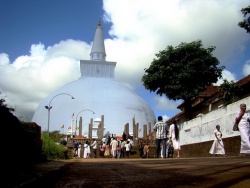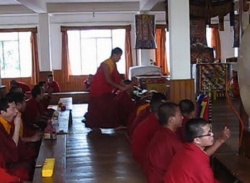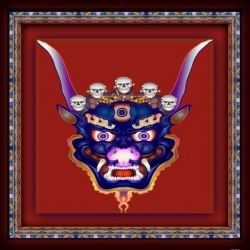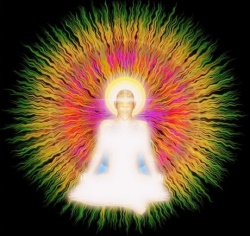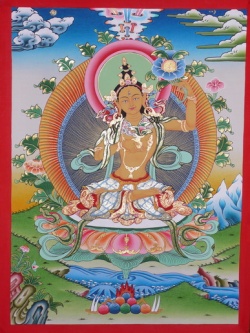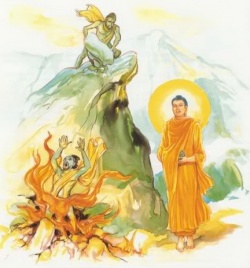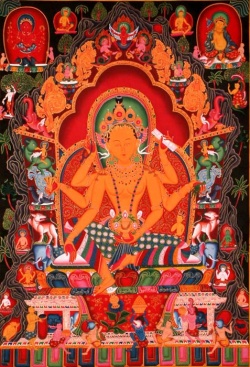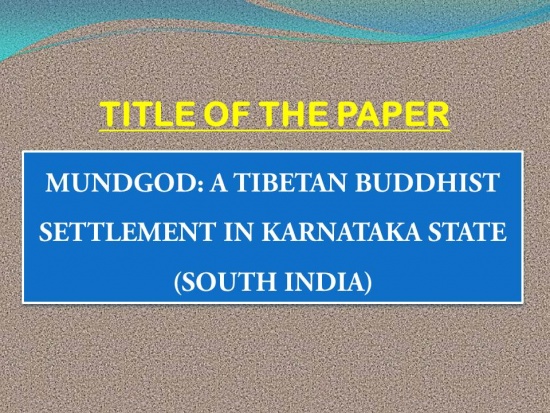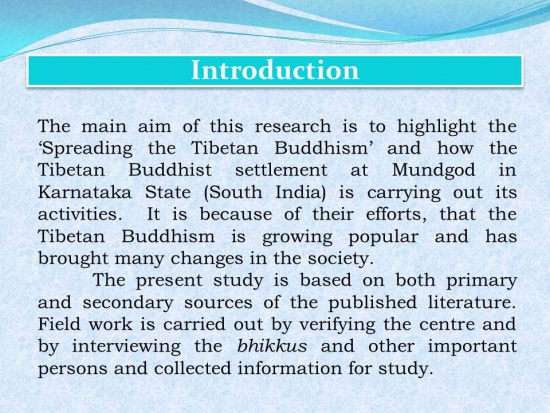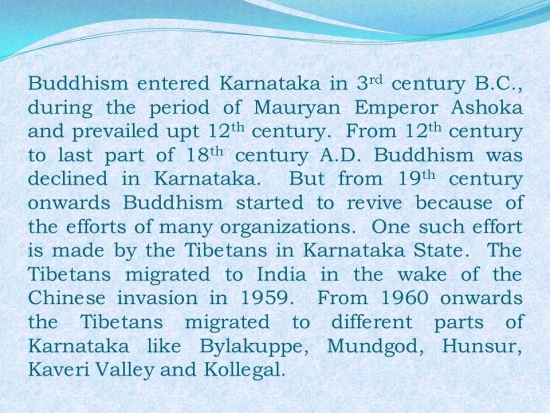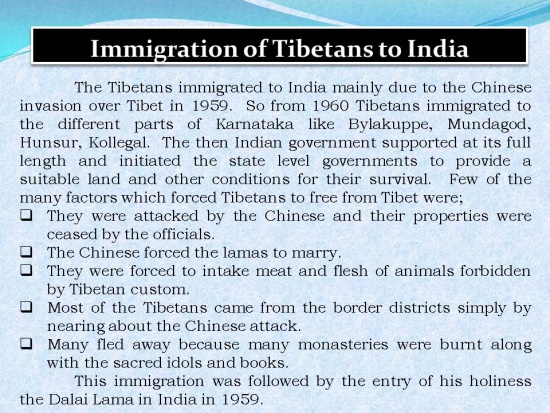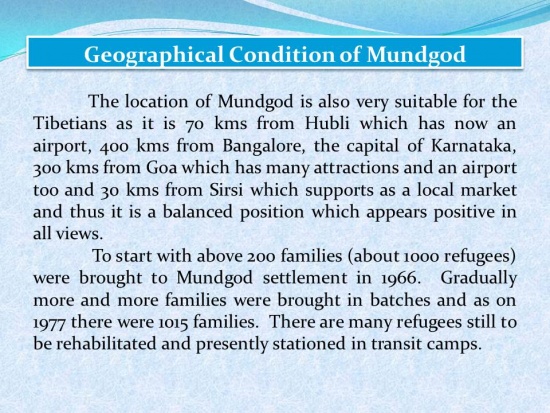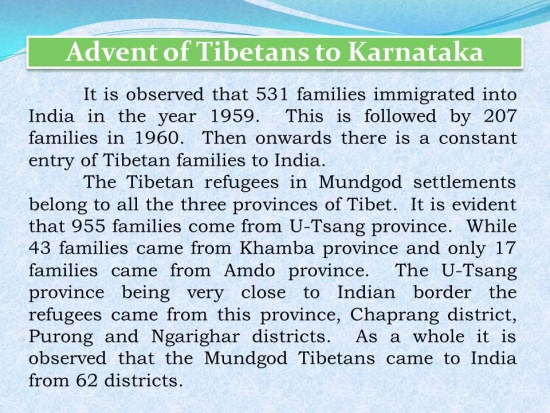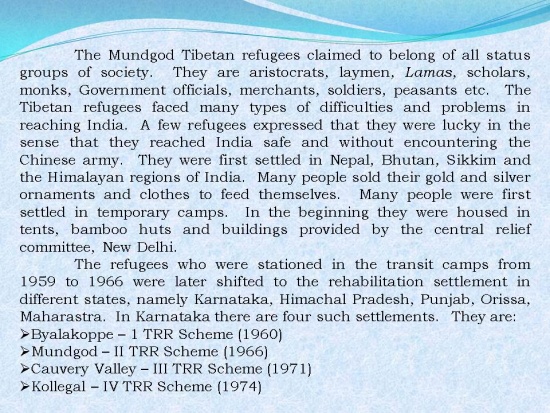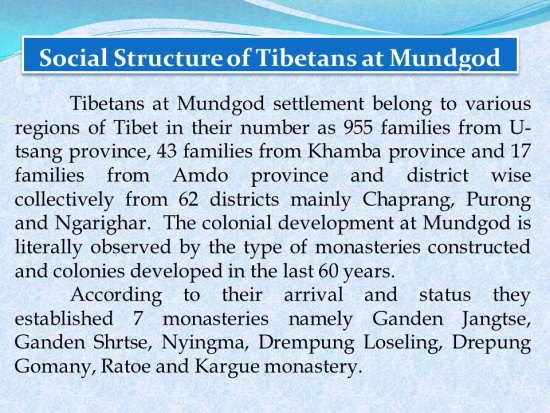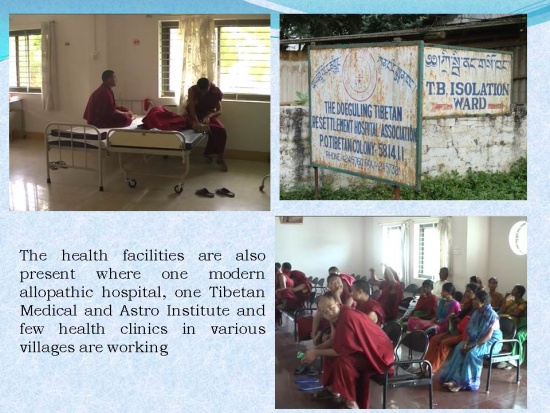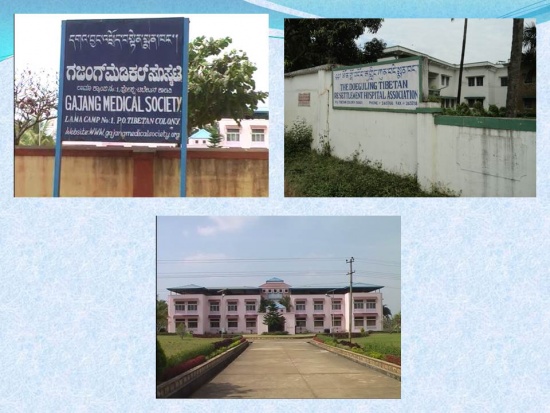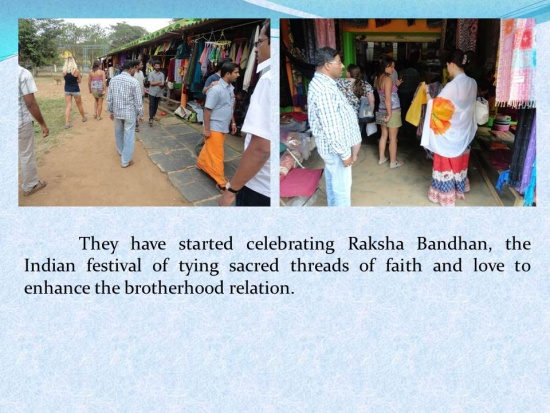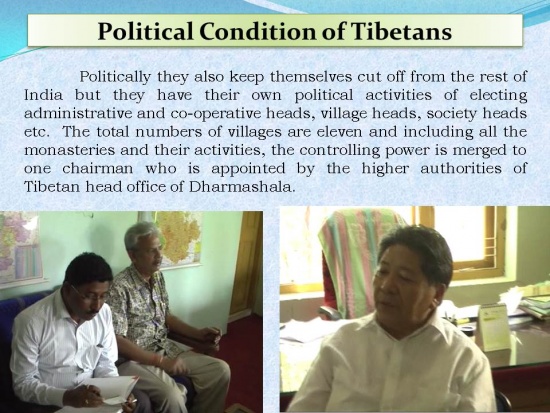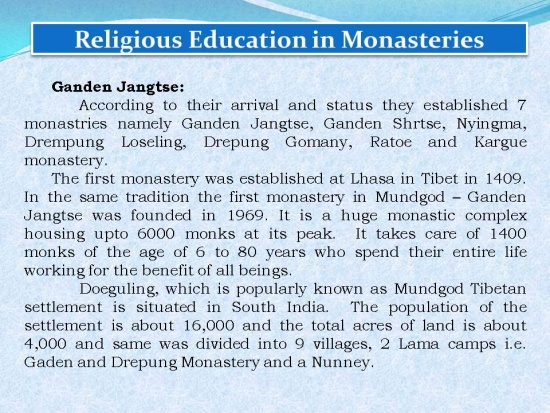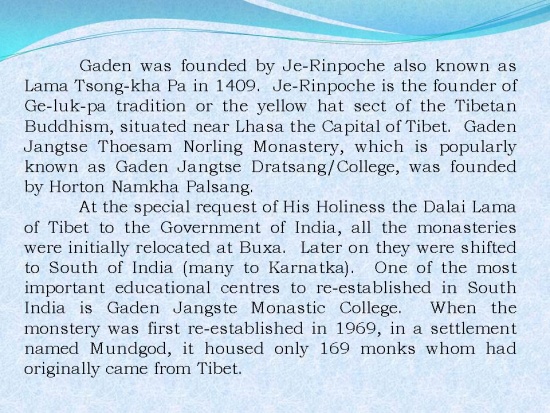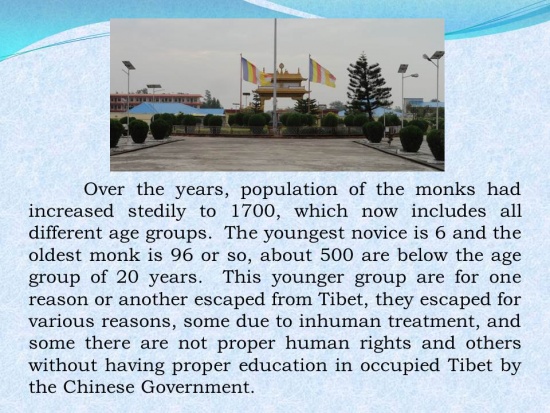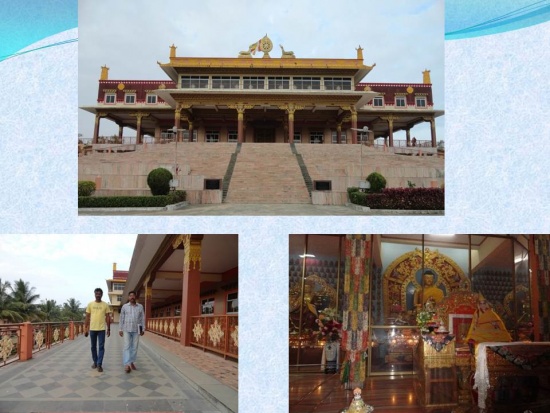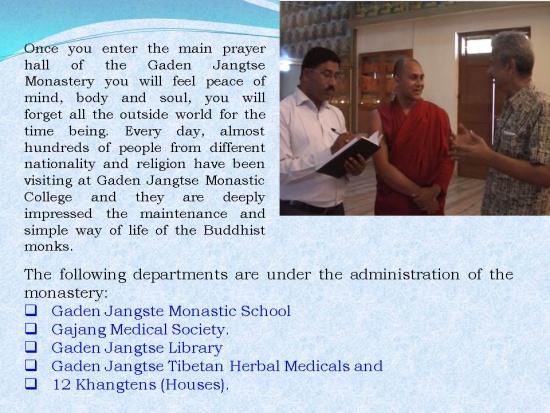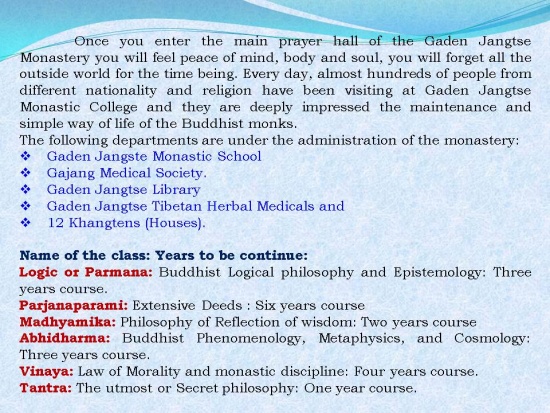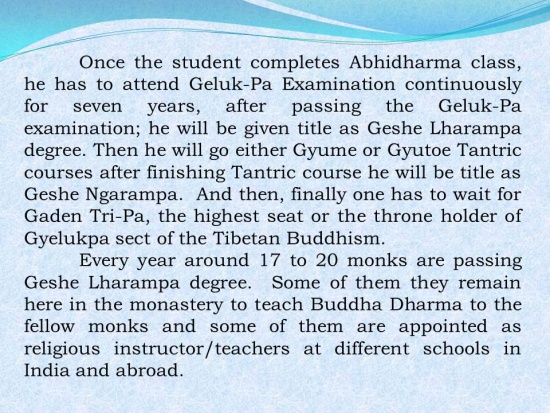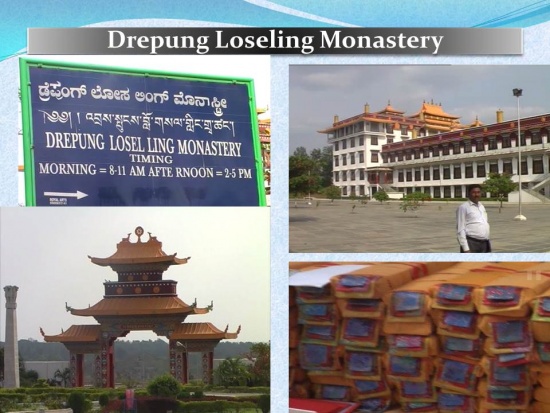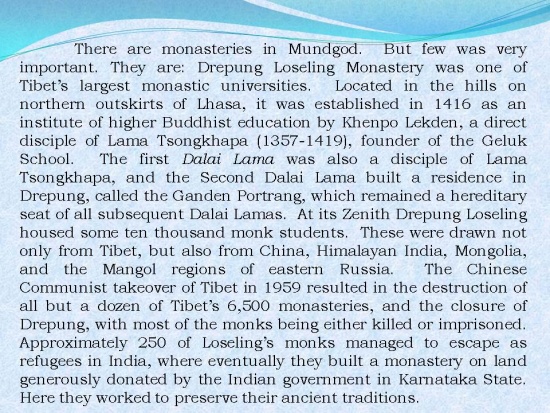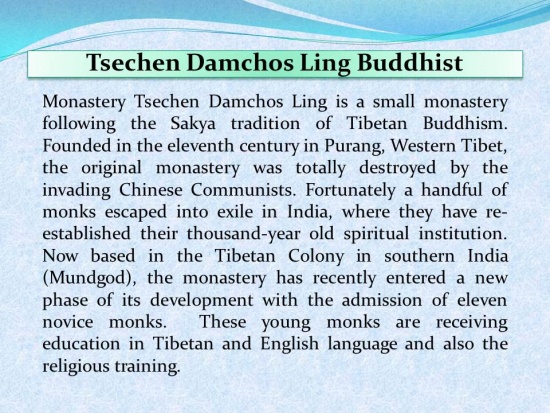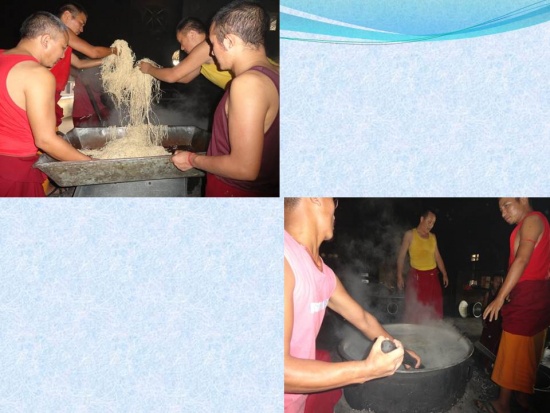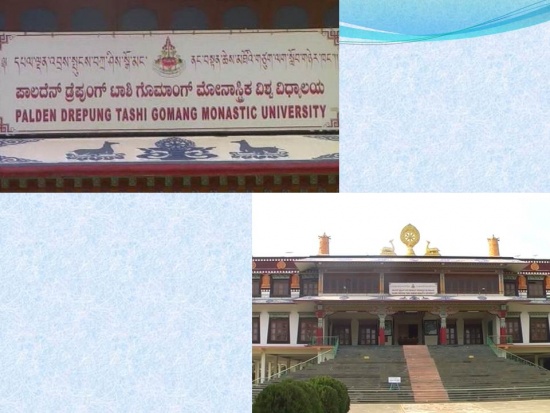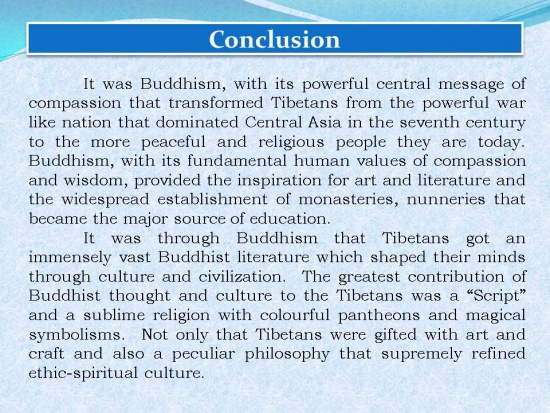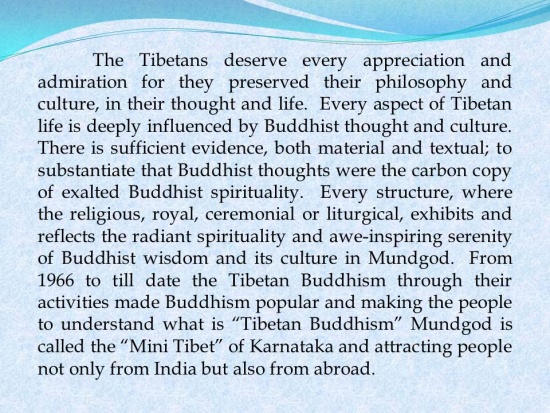Mundgod: a Tibetan Buddhist Settlement in Karnataka State (South India) by Dr. S.G. Chalawadi
Mundgod: a Tibetan Buddhist Settlement in Karnataka State (South India)
Dr. S.G. Chalawadi, Asst. Professor, Dept. of Ancient Indian History & Epigraphy, Karnatak University, Dharwad
Introduction
The main aim of this research is to highlight the ‘Spreading the Tibetan Buddhism’ and how the Tibetan Buddhist settlement at Mundgod in Karnataka State (South India) is carrying out its activities. It is because of their efforts, that the Tibetan Buddhism is growing popular and has brought many changes in the society.
The present study is based on both primary and secondary sources of the published literature. Field work is carried out by verifying the centre and by interviewing the bhikkus and other important persons and collected information for study.
Tibetan Buddhism is also called Vajrayana, Tantric Buddhism and Lamaism. This type of Esoteric School is found principally in Tibet and also now found in Mongolia, India and parts of China. Esoteric is a general term for the schools of Buddhism using mantras and mudras as a principal method of cultivation. In practice the term is often used synonymously with the Tantric School of Tibet (Vajrayana). The Esoteric (Secret) teachings of Buddhism are found in the Esoteric and Tendal schools and refer to those doctrines and rituals deeply influenced by Hinduism that developed in India during the seventh and eighth centuries. These teachings, having magical properties, can only be revealed to those who have been properly initiated.
Buddhism entered Karnataka in 3rd century B.C., during the period of Mauryan Emperor Ashoka and prevailed upt 12th century. From 12th century to last part of 18th century A.D. Buddhism was declined in Karnataka. But from 19th century onwards Buddhism started to revive because of the efforts of many organizations. One such effort is made by the Tibetans in Karnataka State. The Tibetans migrated to India in the wake of the Chinese invasion in 1959. From 1960 onwards the Tibetans migrated to different parts of Karnataka like Bylakuppe, Mundgod, Hunsur, Kaveri Valley and Kollegal.
Many Factors Forced the Tibetans to Flee from Tibet
- 1. Most of the Tibetans coming from the border districts of India simply heard the news of attack of the Chinese and fled to India.
- 2. A few families were directly attacked by the Chinese since they were either officials or wealthy. Their property and even many numbers of their family were taken away.
- 3. The communist polices were not acceptable to the Tibetans since they took away all their rights from social, ritual and economic life.
- 4. Many families were attacked during night with machine guns killing most of them. So, the remaining fled.
- 5. They feared that the Chinese might ask them to send their children to schools in China.
- 6. Chinese forced the Lamas in Tibet to marry.
- 7. The people were forced to eat meat and flesh of the animals forbidden by the Tibetan custom.
- 8. A few Tibetans had planned to fight against the Chinese, but they were caught and sentenced to death. Others knowing this fled away.
- 9. Many fled away because the monastery where there were Lamas was burnt along with the sacred idols and the books.
These few reasons which led the Tibetans to learn their country. Above all since their supreme head His Holiness the Dalai Lama had fled to India they too followed him. The arrival of Tibetan refugees into India began immediately after the entry of His Holiness the Dalai Lama into India in the year 1959. Even today Tibetan refugees continue to arrive in India. A survey conducted among the Mundgod Tibetans shows that every year fresh refugees arrive in Mundgod settlement.
List of Tibetans and the Places of Their Arrival
It is observed that 531 families immigrated into India in the year 1959. This is followed by 207 families in 1960. Then onwards there is a constant entry of Tibetan families to India.
The Tibetan refugees in Mundgod settlements belong to all the three provinces of Tibet. It is evident that 955 families come from U-Tsang province. While 43 families came from Khamba province and only 17 families came from Amdo province. The U-Tsang province being very close to Indian border the refugees came from this province, Chaprang district, Purong and Ngarighar districts. As a whole it is observed that the Mundgod Tibetans came to India from 62 districts.
The Mundgod Tibetan refugees claimed to belong of all status groups of society. They are aristocrats, laymen, Lamas, scholars, monks, Government officials, merchants, soldiers, peasants etc. The Tibetan refugees faced many types of difficulties and problems in reaching India. A few refugees expressed that they were lucky in the sense that they reached India safe and without encountering the Chinese army. They were first settled in Nepal, Bhutan, Sikkim and the Himalayan regions of India. Many people sold their gold and silver ornaments and clothes to feed themselves. Many people were first settled in temporary camps. In the beginning they were housed in tents, bamboo huts and buildings provided by the central relief committee, New Delhi.
They were later temporarily settled in transit camps in various centres like Simla, Ladakh, Gangtok, Dharmasala, Mossourie, Dehradun, Mindry, Dalimpong, Chamba, Delhi. These places are from the states of Himachal Pradesh, Uttar Pradesh, Arunachal Pradesh, Assam, Madhya Pradesh, Sikkim, Nagaland etc. In these camps they were provided with free food to start with. Later they were provided with a few job opportunities where they worked and earned their livelihood. (The Mundgod Tibetan refugees said they had a very critical time at the transit camps since there was scarcity of space and other daily needs).
Apart from these there were also grave problems faced by the young and infants in the transit situation. Several schools were opened for them in places like Dharmasala, Darjeeling, Dalhousie, Panchamari and Simla to provide basic and technical education. The refugees who were stationed in the transit camps from 1959 to 1966 were later shifted to the rehabilitation settlement in different states, namely Karnataka, Himachal Pradesh, Punjab, Orissa, Maharastra. In Karnataka there are four such settlements. They are:
- Byalakoppe – 1 TRR Scheme (1960)
- Mundgod – II TRR Scheme (1966)
- Cauvery Valley – III TRR Scheme (1971)
- Kollegal – IV TRR Scheme (1974)
Geographical Condition of Mundgod
Mundgod area was selected for their settlement for many reasons like the spaceness of population and presence of forest land. The initial reason for the establishment of the Tibet Colony in Mundgod was to develop the area and bring more land under cultivation. The other factors were the climate of the area was more suitable to Tibetans as it received rain for all the six months in a year and even the summer is also reasonably cool.
As a first step in 1977, the chief secretary to the Government of Karnataka, forwarded a scheme to the ministry of external affairs, New Delhi. The scheme was approved and the forest department, government of Karnataka released 4045.29 acres of forest land to the Tibetan settlement.
To start with above 200 families (about 1000 refugees) were brought to Mundgod settlement in 1966. Gradually more and more families were brought in batches and as on 1977 there were 1015 families. There are many refugees still to be rehabilitated and presently stationed in transit camps.
Mundgod is a municipal town in Uttar Kannada District of Karnataka State. Doeguling Tibetan Buddhist settlement is located forty five kilometers away from Hubli-Dharwad (in North Karantaka). It was founded in 1966 by the Tibetans. At present there are nine camps with seven monasteries and a Nunnery. Mundgod is the repository of Tibetan life and culture. It has rightly earned the name “Mini Tibet”. The Government of Karnataka provided 4,000 acres of forest land for the Tibetans to settle here. Initial Tibetan population of the Doeguling Tibetan settlement in Mundgod comprises eleven villages, of which two villages named (Drepung and Gandm) are exclusively for monasteries. These eleven villages are settled over different locations. Each village has its own elected leader who takes all major decisions relating to his village. Mundgod is an excellent centre of monastic education. The famous monasteries in Mundgod are Drepung Loseling Monastery, Gadem Jangtse Monastery, Tschen Damchasling Monstery, Sakya Monastery and Drepung Gomang Monastery.
What is Tibetan Buddhism?
Buddhism was once a vibrant and thriving religion, which dominated in the field of religion on the Indian sub-continent. When it began to decline from the land of its origin, it took refuge in the Himalayan regions and in the land of snows, Tibet. Following upon its introduction into Tibet, over the course of several centuries, it assumed its own particular form, while not losing its essential character and spirit. Tibetan Buddhism preserved and extended the religious culture of the Vajrayana, the final development of Buddhism in India. In Tibet, Buddhism flourished under many qualified teachers both from India and Tibet.
Tibet greatly followed the Mahayana and Tantrayana Buddhist traditions. It is also noteworthy that most of the missionary work was started in Tibet in the seventh century A.D. During seventh and eighth centuries a lot of missionary work was completed in Tibet due to the two wives of Tibetan King Srong-bstan-gam-po and two learned Indian pandits Santaraksita and Padmasambhava with the establishment of Samye Monastery. Padmasambhava went from Bengal those days Palas were ruling. The region of the kings of Pala dynasty was a great epoch in the history of Buddhism in India. The Pala Kings ruled in eastern India from about the second half of the eighth century A.D. and gave a new life to Buddhism.
Buddhist Sects of Tibet and their Founders
Tibetan Buddhism came into existence with a view to preserve the purity of the Buddhist teachings and doing away with degrading practices, superstitions and beliefs.
There were no sects in Tibet prior to the eleventh century A.D. In the eleventh century A.D. the king of Tibet to whom Buddhist renaissance owed much, invited Atis’a (Dipankara Srijnana) to come to Tibet from India to propagate Buddhism there. Since Atisa came to Tibet he corrected, rectified and systematized the Buddhist teachings prevalent there. He reformed the Sangha in Tibet and brought a great renaissance in the religion with his reformation originated Kadam-pa-sect, the first sect of Tibetan Buddhism as against the unreformed type of Buddhism called Nin-ma-pa “the old ones” founded by Padmasambhava, better known as Guru Rinpoche.
Tibetan Buddhism got fractured into various sects from the time of Atisa. Only a few of them are still surviving. There are five major sects or order of Tibetan Buddhism. They are:
- Nyingmapa (Svim-ma-pa)
- Sakyapa (Sa-skya-pa)
- Kargyupta (Bkah-rgyad-pa)
- Kadampa (Bkah-gadams-pa)
- Gelukpa (Dge-lugs-pa)
- 1. Nyingamapa Sect
This sect was founded by Guru Padmasambhava during the region of Khri-sran-Ide-btsan in eighth century A.D. This sect is also known as the “Red cap” sect from the peculiar “Red cap” worn by the Lamas. It is also known as the old Translation sect as its fundamental teachings are selected from the texts translated by Guru Padmasambhava, Acharya Santiraksita, Mahapandita, Vimalamitra of Kashmir and others. This sect is sub-divided into several sub-sects ‘based on the adoption of different revelations’. Prominent among them are Dorje-tak-pa, Nindol-lin-pa, Kar-tok-pa and Na-dak-pa.
The Nying-ma-pa sect divides the entire Buddha Dharma from the sutra to the Tantra into nine yanas which are three Hetulaksanayanes (Yanas of cause) and six Phalavajrayanas (Vajrayana of result). The three Hetulaksanayanas are Sravakayana, Pratyeka Budhayana, and Bodhisattvayana. The six Phalavajrayanas are the three outer Tantras and the three inner Tantras. The three outer Tantras are Kriyayoga, Caryayoga and Yogatantra. The three inner Tantras are Mahayoga, Anuyoga and Atiyoga. Nying-ma-pa sect was inaugurated by Guru Padmasambhava in Tibet.
Nying-ma-pa sect was followed by the royal families and they also included into their missionary activities the lower classes of the people of Tibet. By this process the Bon religion and the popular belief were, as far as it was considered justifiable, incorporated into the frame of Buddhism in changed form. This is probably the explanation of the statement that Padmasambhava placed the native spirit under oath (damcan) to serve Buddhism in the future and that they fulfilled their oath. This assimilation of the Bon religion and the popular belief continued, although scholars of the old school fought against excessive assimilation. (Heera, Bhupendra, 2007, pp. 155-157).
- 2. The Sa-skya-pa sect
This sect arose in the eleventh century A.D. with Kon-mchagrgyal-po. Properly sparking that Sa-skya-pa also traced its origins to Padmasambhava since the khon family, to which Kon-mchog-rgyal-po belonged, had a representation among seven Tibetans chosen by Padmasambhava for ordination.
- Principles of Sa-sky-pa sect
The Sa-sky-pa sect follow the spiritual path known as Mahamudra, but specifically they are known for the path Lam-bras (the path and result of the Sa-skya-pa) teaching, which is attributed to the mahasiddha, Virupa and was brought to Tibet by the great translator, Brog-mi. In addition the great translator Rim-chen-bzang-po is also connected with the Sa-skya religious tradition. The Sa-skya-pa sect has been relatively cohesive, although in the fifteenth and sixteenth centuries A.D. it did see the rise of the two sub-sects, the Nor-pa and Tshar-pa. The Sa-skya-pa tradition however did decline considerably in religious and political importance in recent centuries. (Della Santina, Krishna Ghosh 1949, pp. 37-38).
- 3. Ka-brgynd-pa Sect
This sect traces its origin and religious teaching to the great translator, Marpa, who is said to have visited India thrice and to have obtained instructions from the great mahasiddha, Naropa. Marpa had a number of able disciples in Tibet among whom the most famous was Mid-la-ras-pa. Indeed Mid-la-ras-pa is perhaps the best known of any Tibetan religious figure to the non-Tibetan public. Another disciple of Marpa was Gam-po-pa who authored the Jewel ornament of Liberation a general work on the spiritual discipline of the Mahayana.
- 4. The Ge-lugs-pa sect
This sect arose in the fifteenth century A.D. The venerable monk Tsong-kha-pa is credited with being its founder. It arose out of Sa-skya-pa order and thus it is indebted to the Sa-skya-pa for most of its Tantric teaching. The Ge-lugs-pa saw itself as a reformed sect in as much as it advocated strict observance of moral discipline. In this way it drew its inspiration from the figure of Atisa to whose precepts they accorded great importance. Atisa in generally considered as the founder of the Ka-gdams-pa school which flourished for some time but was eventually absorbed into the Ge-lugs-pa.
The Ge-lugs-pa sect grew rapidly in power and influence and by the sixteenth century, it had assumed secular power in Tibet, and the institution of the Dalai Lama had been established. The dominance of the Ge-lugs-pa in political and religious affairs of Tibet remained virtually unchallenged from then until the time of their flight from Tibet. (Ibid., pp. 38-39).
- 5. Kadampa Sect
There is one more sect named Kadampa sect which is existed in Tibet but its influence is not seen in Mundgod.
DALAI LAMAS
“Dalai Lama” is not the personal name, but “the name of an office” that is currently hold by “a human being who chooses to be a Buddhist monk”. Historically the Dalai Lamas as individuals and as an institution have been closely connected with the welfare of Tibet, her people and their culture. It is within the context of Buddhism that the Dalai Lamas came to prominence. The early Dalai Lamas excelled as spiritual teachers and practitioners. The first, second and third Dalai Lamas in particular were highly accomplished in spiritual and scholarly matters, whereas the fifth and thirteenth Dalai Lamas were in addition politically adept.
Tenzin Gyatso, the Fourteenth Dalai Lama
Tenzin Gyatso (1935 till date) the Fourteenth Dalai Lama has worked to ensure the survival of Tibetan identity and culture. Since leaving Tibet till date. He has also proposed reforms in the governing of Tibet and even the institution of the Dalai Lama itself. As a result of his efforts the Dalai Lama has taken an international profile becoming in his own words “a global spiritual guide”, whose responsibility is to see to the purity of the Buddhist religious institutions and make sure “none of the great lines of descent is lost”. He has acted without rancor towards those who are oppressing him and his people.
As the Chinese consolidated their position in Tibet through secure repression, thousands of Tibetans followed the Dalai Lama into exile. The present Dalai Lama has consistently advanced a peaceful and non-violent approach towards regaining Tibetan independence.
The fourteenth Dalai Lama is having some profound influence in effecting change in that of the status of women in Tibetan Buddhism. The bhikkuni lingege was never transmitted to Tibet. The Dalai Lama has also supported the full education of Nuns towards the geshe degree in the Tibetan Buddhist tradition. (Verhaegen, Ardy, 2002, pp. 160)
Stresses the need for the practice of altruism and kindness in the world to Tibetans everywhere and to a growing number of admirers worldwide the Dalai Lama truly is the embodiment of compassion. The lineage of the Dalai Lamas directly benefited from the ascendency of the Gelugpa hierarchy.
Tibetan Buddhist Monasteries in Mundgod
Drepung Loseling Monastery: There are monasteries in Mundgod. But few was very important. They are: Drepung Loseling Monastery was one of Tibet’s largest monastic universities. Located in the hills on northern outskirts of Lhasa, it was established in 1416 as an institute of higher Buddhist education by Khenpo Lekden, a direct disciple of Lama Tsongkhapa (1357-1419), founder of the Geluk School. The first Dalai Lama was also a disciple of Lama Tsongkhapa, and the Second Dalai Lama built a residence in Drepung, called the Ganden Portrang, which remained a hereditary seat of all subsequent Dalai Lamas. At its Zenith Drepung Loseling housed some ten thousand monk students. These were drawn not only from Tibet, but also from China, Himalayan India, Mongolia, and the Mongol regions of eastern Russia. The Chinese Communist takeover of Tibet in 1959 resulted in the destruction of all but a dozen of Tibet’s 6,500 monasteries, and the closure of Drepung, with most of the monks being either killed or imprisoned. Approximately 250 of Loseling’s monks managed to escape as refugees in India, where eventually they built a monastery on land generously donated by the Indian government in Karnataka State. Here they worked to preserve their ancient traditions.
Gaden Jangste Monastery: Named Gaden (Tushita in Sanskrit), the abode of the Future Buddha Maitreya, the monastery was officially established at Lhasa in Tibet in 1409. Gaden thus became the first main monastery of the Gelugpa tradition; a huge monastic complex (second largest of the tradition) housing up to 6,000 monks at its peak. In 1959 Gaden, along with the vast majority of Tibetan monasteries, was ransacked and bombed into rubble by the Communist Chinese army, now occupying Tibet. About 300 Gaden monks were able to escape from Tibet moving to the South of India. In mundgod Gaden monastery was built in 1969 allowing the monks to continue their studies and practice of Dhamma. Now the same monastery serves over 3,000 monks. The North College, Gaden Jangtse cares for over 1,400 monks, from 6 to over 80 year old, who spend their entire live working for the benefit of all sentient beings.
Tsechen Damchos Ling Buddhist: Monastery Tsechen Damchos Ling is a small monastery following the Sakya tradition of Tibetan Buddhism. Founded in the eleventh century in Purang, Western Tibet, the original monastery was totally destroyed by the invading Chinese Communists. Fortunately a handful of monks escaped into exile in India, where they have re-established their thousand-year old spiritual institution. Now based in the Tibetan Colony in southern India (Mundgod), the monastery has recently entered a new phase of its development with the admission of eleven novice monks. These young monks are receiving education in Tibetan and English language and also the religious training.
Conclusion
It was Buddhism, with its powerful central message of compassion that transformed Tibetans from the powerful war like nation that dominated Central Asia in the seventh century to the more peaceful and religious people they are today. Buddhism, with its fundamental human values of compassion and wisdom, provided the inspiration for art and literature and the widespread establishment of monasteries, nunneries that became the major source of education.
It was through Buddhism that Tibetans got an immensely vast Buddhist literature which shaped their minds through culture and civilization. The greatest contribution of Buddhist thought and culture to the Tibetans was a “Script” and a sublime religion with colourful pantheons and magical symbolisms. Not only that, Tibetans were gifted with art and craft and also a peculiar philosophy that supremely refined ethic-spiritual culture. The Tibetans deserve every appreciation and admiration for they preserved their philosophy and culture, in their thought and life. Every aspect of Tibetan life is deeply influenced by Buddhist thought and culture. There is sufficient evidence, both material and textual, to substantiate that Buddhist thoughts were the carbon copy of exalted Buddhist spirituality. Every structure, where the religious, royal, ceremonial or liturgical, exhibits and reflects the radiant spirituality and awe-inspiring serenity of Buddhist wisdom and its culture in Mundgod. From 1966 to till date the Tibetan Buddhism through their activities made Buddhism popular and making the people to understand what is “Tibetan Buddhism” Mundgod is called the “Mini Tibet” of Karnataka and attracting people not only from India but also from abroad.
References
- Arkeri, A.V. 1998, ‘Tibetans in India the Uprooted People and their Cultural Transplantation’, Reliance publishing house, New Delhi.
- Charles Bell, 1928, ‘The People Tibet’, London Oxford University Press.
- Jumpha, Thupten, 2000, ‘Demographic Analysis of Tibetan Population in Mundgod: A Geographical Perspective’, Unpublished M.Phil Thesis.
- Palakshappa, T.C. 1978, ‘Tibetans in India: A Case Study of Mundgod Tibetans’, Sterling Publishers Pvt. Ltd., New Delhi.
- Richardson, H.E. 1962, ‘Tibet and its History’, London Oxford University Press.
- Anstine Waddell, 1974, ‘Buddhism and Lamaism of Tibet’, Heritage publishers, New Delhi.
- Gyatsho Tshering (Ed.), 1976, The Tibet Journal, Vol. 1, Library of Tibetan works and Archives, Dharmasala, Dist: Kangra, H.P., India.
- Debiprasad Chattopadhyaya (Ed.) 1990, ‘Taranatha’s History of Buddhism in India’, Motilal Banarsidas Publishers Pvt. Ltd., Delhi.
- Madhusudan Sakya, 2011, ‘Buddhism Today Issues and Global Dimensions’, Cyber Tech Publications, New Delhi.
- Krishna Ghosh Della Scentina, 2003, ‘The Tibetan Tantric Vision’, D.K. Print World (P) Ltd., New Delhi.
- Nagaraju, S. (Ed.) 2002, ‘Buddhism in South India’, Seminar Papers, Vol I & II, The Mythic Society, Bangalore.
Power Point Presentation
Source
By Dr. S.G. Chalawadi, Asst. Professor, Dept. of Ancient Indian History & Epigraphy, Karnatak University, Dharwad
The third International Conference Buddhism & Australia 2014
